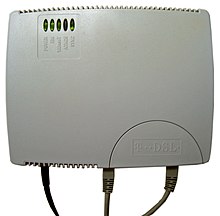Digital subscriber line


DSL or xDSL, is a family of technologies that provide digital data transmission over the wires of a local telephone network. DSL originally stood for digital subscriber loop, although in recent years, many[who?] have adopted digital subscriber line as a more marketing-friendly term for the most popular version of consumer-ready DSL, ADSL. DSL uses high frequency; regular telephone uses low frequency.
Typically, the download speed of consumer DSL services ranges from 512 kilobits per second (kbit/s) to 24,000 kbit/s, depending on DSL technology, line conditions and service level implemented. Typically, upload speed is lower than download speed for Asymmetric Digital Subscriber Line (ADSL) and equal to download speed for Symmetric Digital Subscriber Line (SDSL).
Voice and data
Some variants of DSL connections, like ADSL and very high speed DSL (VDSL), typically work by dividing the frequencies used in a single phone line into two primary 'bands'. The ISP data is carried over the high frequency band (25 kHz and above) whereas the voice is carried over the lower frequency band (4 kHz and below). (See the ADSL article on how the high frequency band is sub-divided). The user typically installs a DSL filter on each phone. This filters out the high frequencies from the phone, so that the phone only sends or receives the lower frequencies (the human voice). The DSL modem and the normal telephone equipment can be used simultaneously on the line without interference from each other.
Equipment
The customer end of the connection consists of a Terminal Adaptor or in layman's terms "DSL modem." This converts data from the digital signals used by computers into a voltage signal of a suitable frequency range which is then applied to the phone line.
In some DSL variations (for example, HDSL), the terminal adapter is directly connected to the computer via a serial interface, using protocols such as RS-232 or V.35. In other cases (particularly ADSL), it's common for the customer equipment to be integrated with higher level functionality, such as routing, firewalling, or other application-specific hardware and software. In this case, the entire equipment is usually referred to as a DSL router or DSL gateway.
Some kinds of DSL technology require installation of appropriate filters to separate, or "split", the DSL signal from the low frequency voice signal. The separation can be done either at the demarcation point, or can be done with filters installed at the telephone outlets inside the customer premises. Either way has its practical and economical limitations. See ADSL for more information about this.
At the exchange, a digital subscriber line access multiplexer (DSLAM) terminates the DSL circuits and aggregates them, where they are handed off onto other networking transports. In the case of ADSL, the voice component is also separated at this step, either by a filter integrated in the DSLAM or by a specialized filtering equipment installed before it. The DSLAM terminates all connections and recovers the original digital information.
Protocols and configurations
Many DSL technologies implement an asynchronous transfer mode ATM layer over the low-level bitstream layer to enable the adaptation of a number of different technologies over the same link.
DSL implementations may create bridged or routed networks. In a bridged configuration, the group of subscriber computers effectively connect into a single subnet. The earliest implementations used DHCP to provide network details such as the IP address to the subscriber equipment, with authentication via MAC address or an assigned host name. Later implementations often use PPP over Ethernet or ATM (PPPoE or PPPoA), while authenticating with a userid and password and using PPP mechanisms to provide network details.
DSL also has contention ratios which need to be taken into consideration when deciding between broadband technologies.
DSL technologies
The line length limitations from telephone exchange to subscriber are more restrictive for higher data transmission rates. Technologies such as VDSL provide very high speed, short-range links as a method of delivering "triple play" services (typically implemented in fiber to the curb network architectures). Technologies likes GDSL can further increase the data rate of DSL.
Example DSL technologies (sometimes called xDSL) include:
- High Data Rate Digital Subscriber Line (HDSL), also covered in this article
- Symmetric Digital Subscriber Line (SDSL), a standardised version of HDSL
- Asymmetric Digital Subscriber Line (ADSL), a version of DSL with a slower upload speed
- ISDN Digital Subscriber Line (IDSL)
- Rate-Adaptive Digital Subscriber Line (RADSL)
- Very High Speed Digital Subscriber Line (VDSL)
- Very High Speed Digital Subscriber Line 2 (VDSL2), an improved version of VDSL
- Symmetric High-speed Digital Subscriber Line (G.SHDSL), a standardised replacement for early proprietary SDSL by the International Telecommunication Union Telecommunication Standardization Sector
- Powerline Digital Subscriber Line (PDSL), a high speed powerline communications solution which modulates high speed data onto existing electricity distribution infrastructure
- UDSL
- Etherloop Ethernet Local Loop
- GDSL Gigabit DSL, based on binder MIMO technologies[1].
Transmission methods
Transmission methods vary by market, region, carrier, and equipment.
- 2B1Q: Two-binary, one-quaternary, used for IDSL and HDSL
- CAP: Carrierless Amplitude Phase Modulation - deprecated in 1996 for ADSL, used for HDSL
- DMT: Discrete multitone modulation, the most numerous kind, otherwise known as OFDM
- OFDM: Orthogonal frequency-division multiplexing
See also
References
- ^ B. Lee, J. Cioffi; et al. (September, 2007). "Gigabit DSL". IEEE Transactions on Communication. 55 (9): 1689–1692.
{{cite journal}}: Check date values in:|date=(help); Explicit use of et al. in:|author=(help)
- Burstein, Dave (2002). DSL. John Wiley and Sons, New York. ISBN 0-471-08390-9. pp 53-86
- Lechleider, Joseph, High Bit Rate Digital Subscriber Lines: A Review of HDSL Progress, IEEE Journal 9:6 (August 1991) pp 769-84
- B. Lee, J.Cioffi, et al, Gigabit DSL, IEEE Transaction on Communication, Sep, 2007, pp 1689-1692
